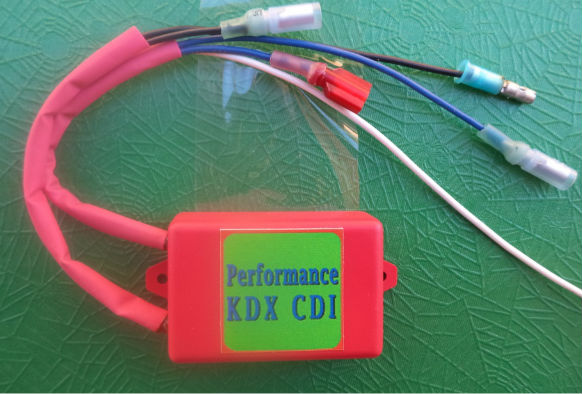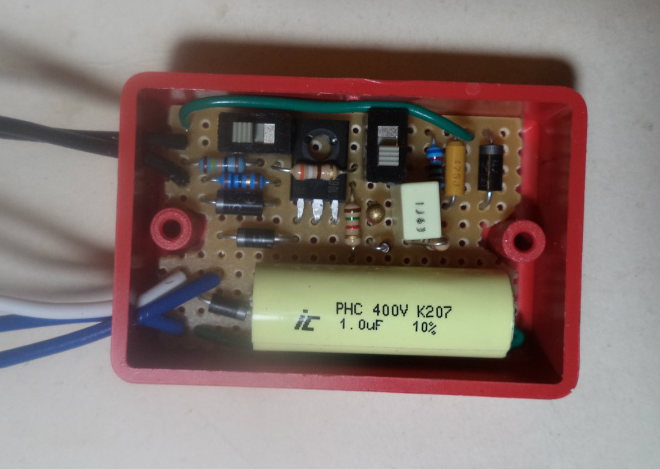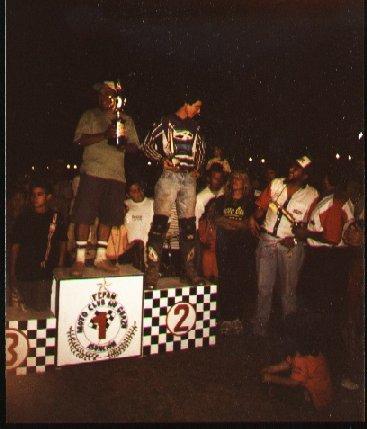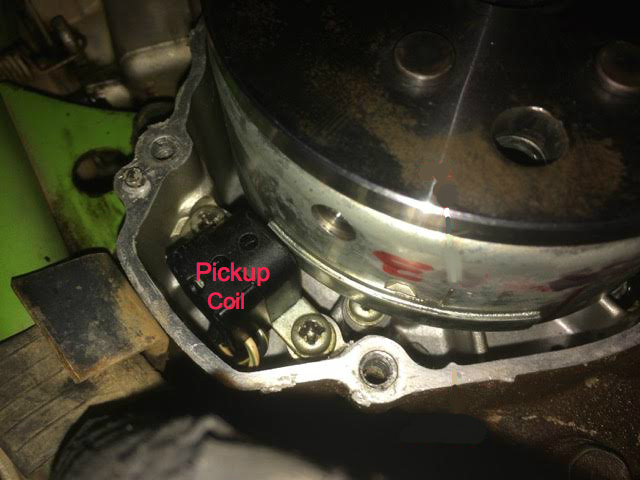|
This is an adjustable CDI to replace the stock non-adjustable CDI. It allows selection of the desired timing curve by use of two switches inside the box.   Why ignition timing is important: There are various factors that change throughout the RPM range which when added together require a certain ignition timing for maximum combustion pressure to occur between 10 and 15 degrees ATDC (after top dead center). Timing which misses that sweet spot causes power loss. Click here to see all the pertinent factors affecting timing requirements. What is an ignition timing curve? If you record the ignition timing (in degrees before top dead center) for every 1000 RPM from idle to peak RPM then you have the needed data to make a timing curve graph on graph paper. That is what I have done dozens of times testing different circuit changes in search of the best timing curve for the KDX. The red graph below shows the Performance CDI with the switch set for the best competition timing curve. It givs more high RPM power from having the timing more retarded.  What about the stock KDX ignition timing? The stock CDI basically has too much spark advance at high RPM. This produces reduced power. Why the engineers selected this powerband probably has to do with its intended use as a trail bike. By rotating the stator coil plate you can adjust for better mid range power or top end power, but not both. KDX Performance CDI timing curve: Its timing curve can be retarded at high RPM for better power there. You will be surprised at how much power you have been missing out on. The engine is ready to give more power but is waiting for the correct spark timing. Via two internal switches you can adjust the timing curve. Quality Control: The KDX Performance CDI does not have the variation of timing between each one than what the original CDI has. The original uses resistors with +/- 5% values, and capacitors with +/- 10% values. At what RPM the timing curve starts to retard depends in part on its resistance of 1264 ohms and capacitance of 4.7uf. So if the resistance is at +5% and the capacitance at +10% one RC time constant is 6.9uSec. And if the resistance is at -5% and the capacitance at -10% then one time constant is 5.1uSec which is 26% less than the maximum 6.9uSec. That is too big a variation. How that translates to real life: That results in a variance of as much as 1050 RPM for when the retard curve starts to kick in according to the original CDI's resistor and capacitor true values. The later the curve kicks in the more the peak timing advance will be which is great for low RPM power but terrible for high RPM power (because the KDX is too advanced anyway at top RPM). This explains the biggest difference between two new KDX bikes, just due to variations in CDI. Standard CDI costs: OEM CDIs are now unavailable for the pre-1995 E model KDX, $431 for H model 1995 on up at Kawasaki Parts House on-line, and $361 at BikeBandit. Just to give you an idea of how much adjustable CDIs cost, the Vortex adjustable CDIs (not for KDX) are $450. Others are more expensive. Spark Strength and Engine Power: You can squeeze even more power out of your engine by increasing the spark strength. 2.5% more engine power is derived from each 33% increase in spark power. This data is from the research paper "Devices to improve the performance of a conventional two-stroke spark ignition engine" which includes these statements: "With the high energy ignition system, combustion stability is improved due to high spark discharge, which initiates the combustion process more effectively at higher compression ratios and with leaner fuel-air mixtures compared to the normal ignition system. At a high compression ratio of 9:1, with lean fuel-air mixture (A/F=15.2), the maximum improvement in brake thermal efficiency obtained with this high-energy ignition system is 16.5% (at 2.76 kW, 3000 rpm)" (Thermal efficiency is the ratio between the mechanical power output and the heat content of the fuel consumed.) I have tested a few ignition coils and now recommend the Honda CR coil because it allows a spark gap of twice as much as most other coils which indicates it is more powerful. Some of them have the same 55mm bolt hole spacing as the KDX. For example, the '97-'99 CR125 & CR250 ignition coil has 55mm hole spacing and 45mm body diameter. I am a dirt bike riding electronics technician and years ago I owned the 1989 Kawasaki KDX 200 SR which was a great dirt bike and had a broad enough powerband to also be good on the street. When the CDI went bad I was told of a man that repaired them. He showed me how to dig into them in order to replace the SCR and charge capacitor which are the two parts normally going bad. I then figured out the schematic for it and the values of all parts used in it. Then I tinkered around with different values of parts in order to get more mid-to-top RPM power. I used that CDI both on the street and on the trails and motocross track. It worked great to say the least, much better than the stock CDI which detunes high RPM horsepower. Years later I figured out how to make a variable RPM bench CDI tester which was needed for complete analization since it is hard to maintain a steady high RPM on a running bike while you look at the ignition timing with a timing light. And it is very hard on the engine reving it high with a no-load situation. Using that tester I was able to figure out the needed parts value changes for adjustable timing curves. So this is a replacement KDX CDI which has selectable timing curves. It has the same five wires with the same type connectors. Two wires connect to the wires from the magneto stator coil, two connect to the motorcycle ignition coil, and one connects to the kill switch. Customer testimony; moto_psycho wrote that my CDI "kicks the shit out of the standard CDI"! Ha! I like that. His post is the second one on this post in the KDXrider forum. Questions & Answers How can I be sure my CDI is bad and needs replacing? Click here to read about how to troubleshoot the ignition system. Does this work on all KDX models? This works on all models that use 5 wires coming from the CDI. If yours is '88 or older then you'll have to buy a high voltage coil also since the stock setup is CDI and coil in one integral unit. There is a model of KDX that uses 6 wires from the CDI. The 6th goes to the instrument panel, maybe to an RPM gauge. I'm not sure. And I don't know where that wire connects into the CDI circuitry. I've not dug into one of those yet. If you have a bad one then send it to me and I'll send you a version of my CDI that will work. It doesn't work on the 220SR because that ignition depends on a pickup coil for its timing which unfortunately is not position adjustable. Here is a picture showing its flywheel and pickup coil:
Is there any possibility of danger to my engine by using this CDI? None at all. Timing changes of a few degrees can produce significant power increases but if the change is incorrect then it only causes a slight power loss. Do you offer
any kind of guarantee with this?
Of course. If you aren't satisfied (or you can't get it to work) then
return it for a refund. Also if it fails within a year you are entitled
to a warranty replacement. What qualifies you to make a good reliable CDI? Well I've been a college educated electronics technician since 1977 and have been manufacturing and selling CDIs (based on the KDX design) for motorized bicycles the last 3 years [page]. Also I owned and motocrossed a KDX200 that had my own modifications done to the CDI so I know what it takes to get more performance out of the KDX. What if the wiring connections are not just as you say they should be? Then just use this guide to wire it correctly: CDI wiring for most KDX's: If your
CDI is different and you want to identify the wires then just know that
the input and kill switch wire are shorted to each other inside the CDI
so that the kill button can short to ground the CDI input voltage. If
your multimeter can test for diode voltage then put the red probe on
the CDI output wire and the black probe on the CDI ground wire and it
should show around .6 volts. If not, then you aren't connecting to the
output and ground wire. The input ground and output ground wires short
together inside the CDI. Click here for instructions for setup and installation of the KDX Performance CDI If you want one just email me (19jaguar75@gmail.com) and I'll send you a PayPal invoice for $199 plus $35 shipping from Ecuador (where I am currently at) to USA. If not in USA then tell me what country you are in so I can find out the shipping cost by DHL.Here's a picture of me with a second place trophy in Paraguay after racing my KDX200SR (with performance CDI) against the country champion in the "enduro bike" division. I was leading him in both motos but got tired and slowed down because I had ridden too much the day before and so got 2nd place the 2nd moto. The next race I left him far behind on a track that was more wide open and had faster straights.  He said he'd like to try my CDI to see if he liked it enough to sell them so I sent him one for free. Then he never tried it and never returned it to me. WTF? Beware of this untrustworthy guy. |
